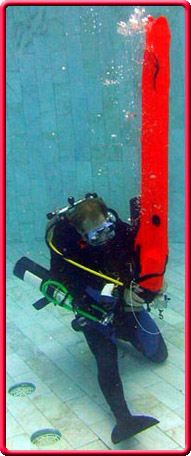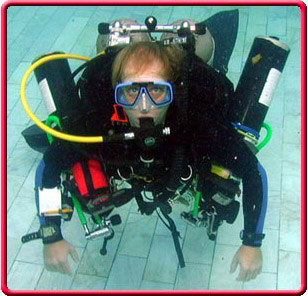 At 66m (215ft) it is cold and dark with an unexpected current
running. At this depth, too much physical exertion could lead to carbon
dioxide build up, convulsions and death, so instead of swimming, we
crawl along the bottom.
At 66m (215ft) it is cold and dark with an unexpected current
running. At this depth, too much physical exertion could lead to carbon
dioxide build up, convulsions and death, so instead of swimming, we
crawl along the bottom.
Inching across the ocean floor I control my breathing by reviewing
the long list of things that could go wrong on this dive, and then
mentally rehearse the required responses. Once more checking all the
valve positions, my thoughts drift to all the other times in my life
I've been crawling along in the
cold, dark, and wet.
 | |
John and I go over a dive plan.
| |
This grim reverie is interrupted when my instructor taps my shoulder,
he's found a sea horse he wants to show me.
Kneeling on the bottom far beyond the recreational diving limits,
and watching this surreal little creature, the world seems to suddenly
come into a little bit better focus.
Down here, it seems self-evident the road less traveled is
always the more interesting, and that's really what technical diving
is about. In our ever shrinking and more traveled world it's another
way of seeking out stones still to be turned.
I've long wanted to take a course in trimix diving, but it
just isn't taught in many places. Since we'd done little research, it
was a surprise to find that not only does Sabang have a trimix instructor,
but a famous one. John Bennett currently holds the world record for the
deepest open water dive
(254m, 833ft) video.
- update:
-
On March 15, 2004, John was reported
missing presumed dead
after a commercial diving job in Korea. Obviously nothing I can say here
will make a difference in that, but, I would like to note, that over the
years I dove with a lot of people, some of the incredibly skilled. John
really stood out to me, not just for his talents in the water, but for
his willingess and ability to teach and share what he knew. The short bit
of time I got to study with him was precious, and the world is definitely
a little smaller without him in it.
We obviously won't be setting any records on my course, but it's
reassuring to learn these arcane skills from such an experienced
diver.
Deep diving is a delicate, and not entirely understood, balance
between the effects of breathing different gasses under pressure.
The air we normally breath is 21% oxygen, 79% nitrogen, and small
quantities of trace elements. In recreational diving, nitrogen is the
primary concern. As divers breath compressed air at depth, the
pressure forces extra nitrogen to dissolve into their bodies. This
excess nitrogen must be off-gassed as the diver ascends.
 | |
|
Practicing with a surface marker buoy.
|
| |
If the ascent is slow enough, there are no problems, but if the diver
comes up too quickly the nitrogen can form bubbles that wreak havoc as
they lodge in joints or sensitive nerve tissue. This is
decompression sickness (DCS), or "the bends," and pain, paralysis,
and death are all possible consequences.
To extend the time they can remain at depth without unreasonably
increasing the risk of DCS, some divers reduce the amount of nitrogen
they breath by adding extra oxygen to their tanks making
nitrox.
But, breathing even normal air at 40m (130ft), the pressure makes the
body respond as if it was breathing 100% oxygen, and going deeper
oxygen toxicity becomes a significant threat.
Unlike DCS which often manifests subtly and only on the surface,
oxygen toxicity causes immediate and dramatic symptoms at depth. Most
common and worrying are convulsions, which cause the diver to
uncontrollably spit out his or her regulator and most likely drown.
An oxygen partial pressure of 1.6 atmospheres is the generally
accepted limit for technical diving and with air this partial pressure
is reached at 66m (215ft). To safely go deeper you need to breath a
gas mix containing less oxygen than normal air.
You could replace the oxygen with more nitrogen, but breathed at high
pressures nitrogen has a narcotic affect, and as tempting as it might
seem, deep dives are not best attempted with dull wits.
An inert gas is needed, and helium has become the most common choice.
With trimix, a blend of oxygen, nitrogen, and helium, the diver is
able to control his or her exposure to oxygen and reduce the narcotic
affect of nitrogen.
Helium doesn't have adverse affects until about 122m (400ft)
where high pressure neurological syndrome (HPNS) becomes a worry.
HPNS gives sudden personality changes, muscle tremors, and
convulsions, but 120m is deeper than I'm planning on going anytime
soon, so I'll worry about it later.
The final dive of my course is planned for 18 minutes at 80m (260ft).
The twin tanks on my back are filled with a mix of 14% oxygen, 40%
helium, and 46% nitrogen. In addition to the twins I carry a small
stage bottle under each arm. The left, lean mix, is 50% oxygen and
50% nitrogen, and then right, rich mix, is 100% oxygen.
|  |
| Geared up for trimix.
|
The mix of gasses in the main tanks is hypoxic, it does not contain
enough oxygen to breath on the surface, so I roll off the boat breathing from
the left stage bottle. At 15m (50ft) there is enough pressure to
breath from our main tanks so we pause our descent to switch gasses and
do a quick check for leaks.
The leak check is important because on our previous dives we have
meticulously measured my breathing rate and this dive has been
carefully planned to match my consumption. Despite the excitement of
going deeper than I ever have ever been before, I must breath slowly
and deeply, or we will have to turn the dive early to stay within our
safety margin.
Resuming our descent we quickly pass through the depths where the lean
mix, and even air would have been dangerous to breath.
Even if it weren't toxic, at our maximum depth of 80m (260ft), normal air
would have to be sucked from my regulator like syrup and the nitrogen
would be dangerously narcotic. The trimix though comes easily, and
my head is clear.
Despite the darkness and the cold, it's easy to imagine that we are far
shallower, but it's a dangerous illusion. At these pressures huge
amounts of nitrogen and helium are rapidly dissolving into my body. In
an uncontrolled ascent the bubbles formed by these gasses would almost
assuredly cripple, if not kill me. There is a hard ceiling above me, just
as assuredly as if we were in a wreck or cave.
Under these circumstances any problem is potentially catastrophic and
we train to deal with them instinctively. The equipment is reliable
and fully redundant, the diver is almost always the weakest link in the
system.
With time and gas checks, simulated equipment failures, and gawking
the occasional fish our 18 minutes of bottom time pass quickly.
Our first decompression stop is at 45m (146ft). On our way there from
the bottom, we are careful to maintain an ascent rate of 10m
(33ft) per minute. Helium is a fast gas and will quickly form
dangerous bubbles if we ascend too rapidly.
From here to the surface we'll do a decompression stop every 3m
(10ft). Drifting in open water as we are, it's difficult to maintain
such precise control of our buoyancy, so we deploy surface marker
buoys (balloons) to the surface, and hang off them by attached lines.
The first several stops are short, most of them just a minute, but
there is a lot to do. In addition to controlling our ascent rate and
getting the SMBs up we need to prepare for the gas switch at 21m
(69ft). I retrieve the regulator from where it's been stowed and turn
on the gas. The switch point is chosen to be just above the danger
level for the 50% mix. Breathing such a high partial pressure of
oxygen helps to flush the dissolved gasses out of my system and the
cumulative oxygen exposure is part of our dive plan.
The partial pressure of the 50% mix drops as we ascend through longer
and longer stops until at 6m (20ft), for our longest (27 minute) stop,
we switch to 100% oxygen at the maximum partial pressure of 1.6.
Hanging from my buoy, drifting through the seas with only plankton
for entertainment, I've got plenty of time to ponder the sense of
this kind of diving.
It's difficult, uncomfortable, hazardous, and intensive in gear and
training. All my favorite things, and they make for an inexorable pull
into depths ever less traveled.
|




